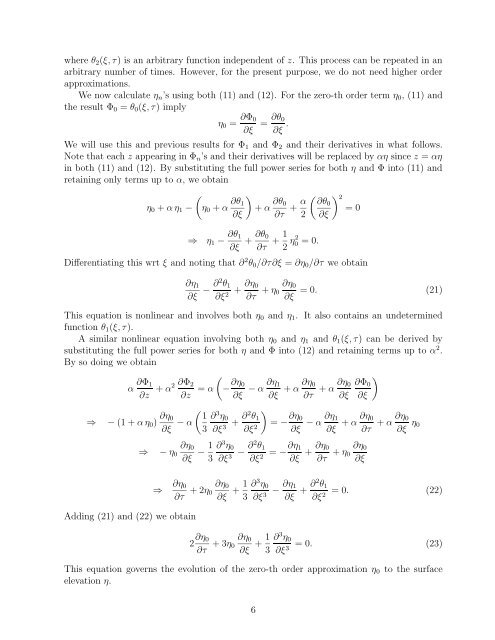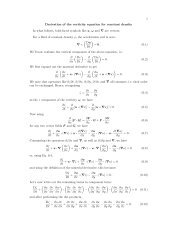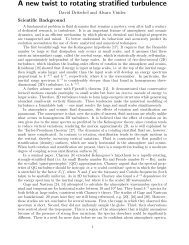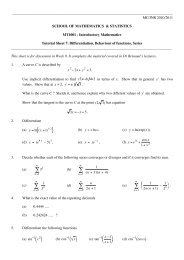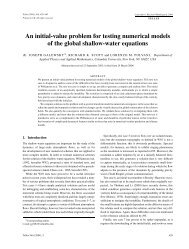Brief notes on the derivation of the KdV equation
Brief notes on the derivation of the KdV equation
Brief notes on the derivation of the KdV equation
Create successful ePaper yourself
Turn your PDF publications into a flip-book with our unique Google optimized e-Paper software.
where θ 2 (ξ, τ) is an arbitrary functi<strong>on</strong> independent <strong>of</strong> z. This process can be repeated in anarbitrary number <strong>of</strong> times. However, for <strong>the</strong> present purpose, we do not need higher orderapproximati<strong>on</strong>s.We now calculate η n ’s using both (11) and (12). For <strong>the</strong> zero-th order term η 0 , (11) and<strong>the</strong> result Φ 0 = θ 0 (ξ, τ) implyη 0 = ∂Φ 0∂ξ = ∂θ 0∂ξ .We will use this and previous results for Φ 1 and Φ 2 and <strong>the</strong>ir derivatives in what follows.Note that each z appearing in Φ n ’s and <strong>the</strong>ir derivatives will be replaced by αη since z = αηin both (11) and (12). By substituting <strong>the</strong> full power series for both η and Φ into (11) andretaining <strong>on</strong>ly terms up to α, we obtainη 0 + α η 1 −(η 0 + α ∂θ )1+ α ∂θ 0∂ξ ∂τ + α 2⇒ η 1 − ∂θ 1∂ξ + ∂θ 0∂τ + 1 2 η2 0 = 0.( ) 2 ∂θ0= 0∂ξDifferentiating this wrt ξ and noting that ∂ 2 θ 0 /∂τ∂ξ = ∂η 0 /∂τ we obtain∂η 1∂ξ − ∂2 θ 1∂ξ + ∂η 02 ∂τ + η ∂η 00∂ξ= 0. (21)This equati<strong>on</strong> is n<strong>on</strong>linear and involves both η 0 and η 1 . It also c<strong>on</strong>tains an undeterminedfuncti<strong>on</strong> θ 1 (ξ, τ).A similar n<strong>on</strong>linear equati<strong>on</strong> involving both η 0 and η 1 and θ 1 (ξ, τ) can be derived bysubstituting <strong>the</strong> full power series for both η and Φ into (12) and retaining terms up to α 2 .By so doing we obtainα ∂Φ 1∂z + ∂Φ (α2 2∂z = α − ∂η 0∂ξ − α ∂η 1∂ξ + α ∂η 0∂τ + α ∂η 0∂ξ)∂Φ 0∂ξ⇒ − (1 + α η 0 ) ∂η ( )0 1∂ξ − α ∂ 3 η 03 ∂ξ + ∂2 θ 1= − ∂η 03 ∂ξ 2 ∂ξ − α ∂η 1∂ξ + α ∂η 0∂τ + α ∂η 0∂ξ η 0∂η 0⇒ − η 0∂ξ − 1 ∂ 3 η 03 ∂ξ − ∂2 θ 13 ∂ξ = −∂η 12 ∂ξ + ∂η 0∂τ + η ∂η 00∂ξAdding (21) and (22) we obtain⇒ ∂η 0∂τ + 2η ∂η 00∂ξ + 1 ∂ 3 η 03 ∂ξ − ∂η 13 ∂ξ + ∂2 θ 1= 0. (22)∂ξ2 2 ∂η 0∂τ + 3η ∂η 00∂ξ + 1 3∂ 3 η 0= 0. (23)∂ξ3 This equati<strong>on</strong> governs <strong>the</strong> evoluti<strong>on</strong> <strong>of</strong> <strong>the</strong> zero-th order approximati<strong>on</strong> η 0 to <strong>the</strong> surfaceelevati<strong>on</strong> η.6


